Parker 75 Americana 1975
by Jim Mamoulides, July 12, 2024
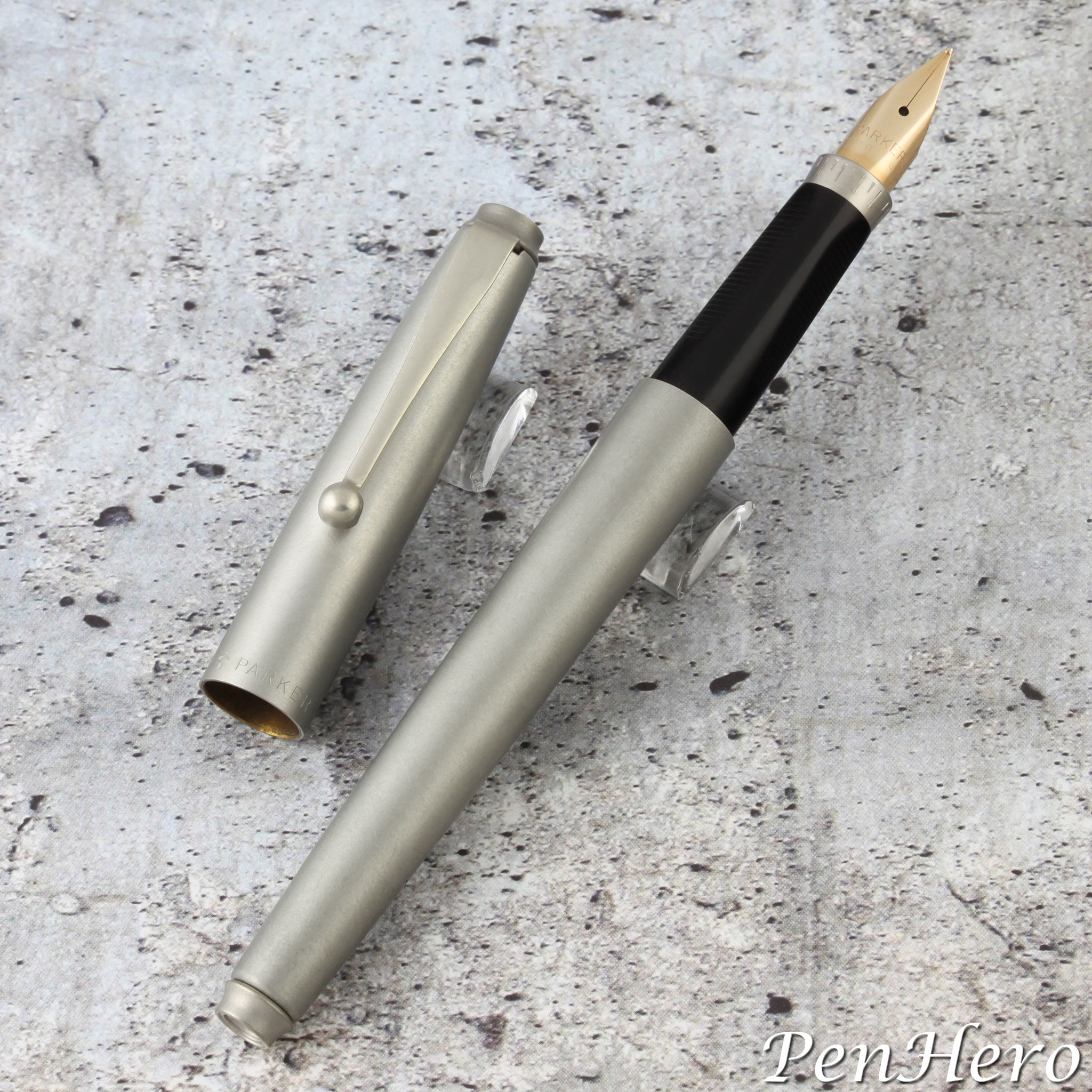 Parker 75 Americana 1975
Parker 75 Americana 1975
A Slice of Americana
The Parker 75 Americana, often called the Parker 75 Bicentennial, is probably the least Parker 75 pen there is. The cap and barrel shape say 75, and with the cap off, the section and nib confirm it. Yet cap on, it’s quite visually different, starting with the clip. Instead of the expected Parker Arrow type found on every other 75, this clip is a tapered bar that ends in a ball and is possibly made from the same pewter as the rest of the pen. Perhaps since the pen is an homage to a much earlier period in American history, Parker thought the clip should also reflect an earlier time, like the ball end 1916 patent clips of the early Parker Duofold and Jack Knife pens. The cap top (crown) and barrel end tassies are also different, tapered and cup like, with the top one having a wood insert.
Parker introduced the 75 in 1963 to commemorate Parker’s 75th anniversary. Production continued in the United States until the week of March 2, 1981 when it was moved to the Parker factory in Méru, France. Parker made several limited editions of the 75, starting with the Spanish Treasure Fleet pen announced in November 1965, an edition of 4,821 crosshatch engraved sterling silver fountain pens and an unknown number of ballpoint pens. The 1976 Parker 75 Americana pen would be the fourth limited edition of the 75 and it was a doozy.
It’s The Bicentennial!
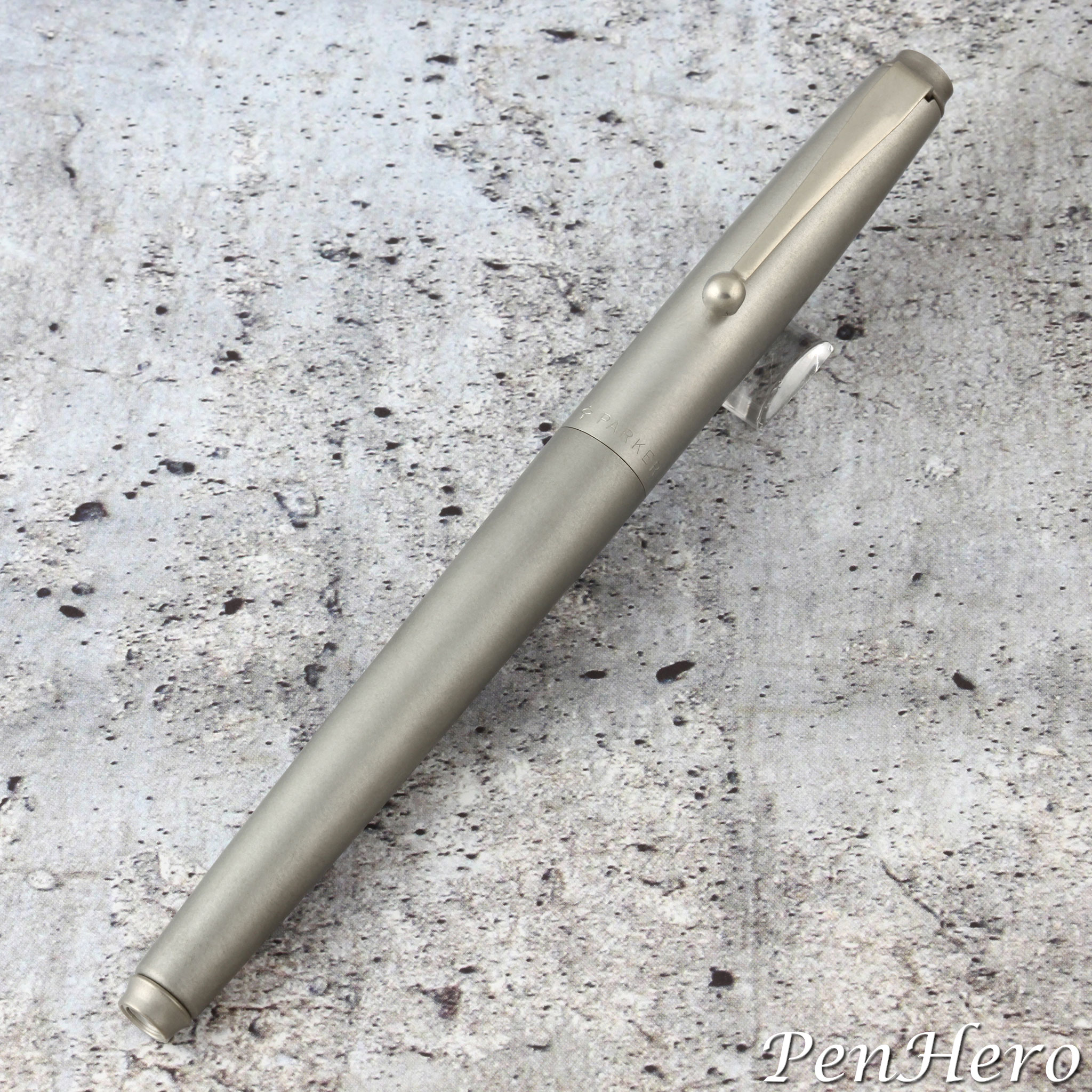 Parker 75 Americana 1975
Parker 75 Americana 1975
Though the edition is called Parker Bicentennial Pens and Desk Sets, the Parker 75 pen itself is called the Parker 75 Americana Pen. Dealer materials are dated May 1975 and the earliest ad I found is in the Sunday News Journal TV section on page 31 of the Wilmington, Delaware Morning News on September 7, 1975. The ad offers the customer a chance to “Hold American History in your hand.”
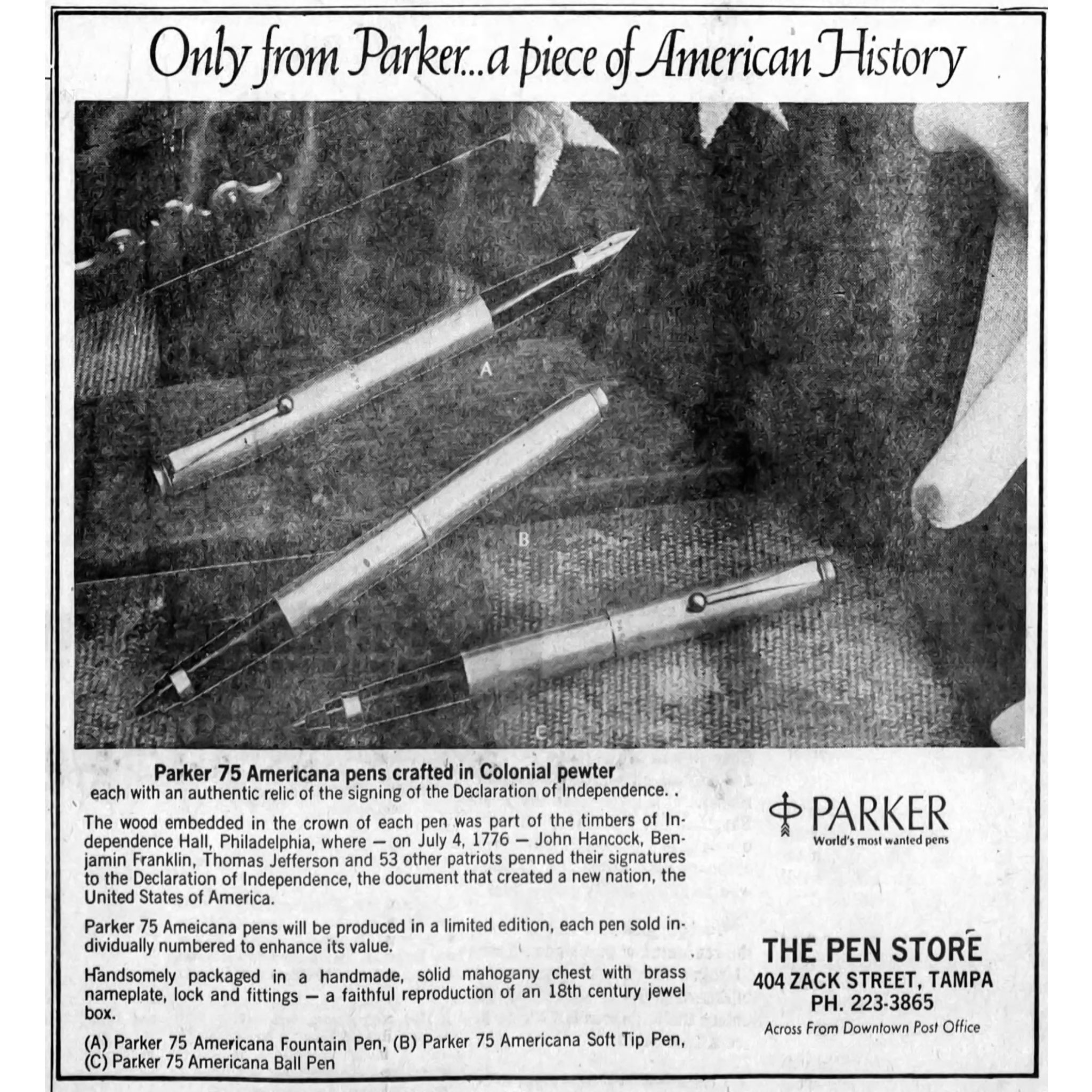 Advertisement in the Tampa Tribune, Tampa, Florida, December 24, 1975
Advertisement in the Tampa Tribune, Tampa, Florida, December 24, 1975
The standard gift box for the 75 Americana is a handmade, key locking mahogany chest with brass fittings and nameplate, designed after an 18th century jewelry box. The Parker 75 Americana was made to celebrate the United States bicentennial, the two hundredth anniversary of the signing of the Declaration of Independence on July 4, 1776. Pewter was chosen as the base metal as it was “widely used in Colonial homes for pitchers, plates, bowls, candleholders, tankards, and other articles,” according to the brochure that came with the pen. Parker points out that the pewter used for the edition was lead free and though it could be polished, it would, like silver, show signs of use, and show a patina over time. It's notable for its lack of cap and barrel decoration other than the engraving on the cap, opposite the clip, followed by the edition number, from 1 to 10,000:
Wood in this limited edition penis a relic of Independence Hall.Philadelphia - 1776X,XXX/10,000
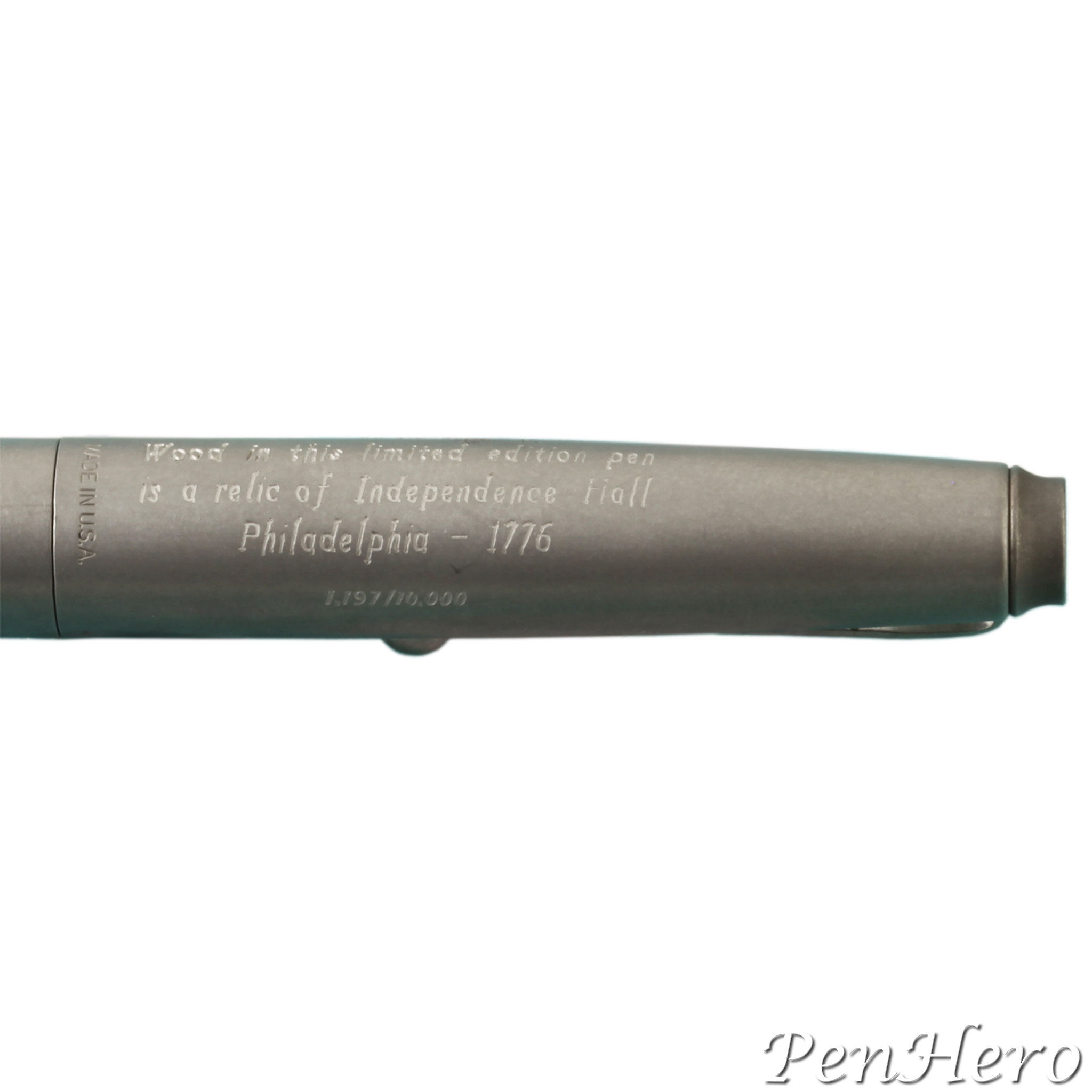 Engraved authenticity inscription on the back of the cap
Engraved authenticity inscription on the back of the cap
The brochure with the pen, “Parker Bicentennial Pens and Desk Sets,” has a photo of John Trumbell’s huge 12 by 18-foot painting of the presentation of the Declaration of Independence at Independence Hall in Philadelphia, Pennsylvania on its cover. To attach a small piece of history to each pen, Parker purchased a stock of authenticated wood taken from the original wood floors and railings removed from Independence Hall when it was restored in 1897. Each pen and desk set includes a small piece of this wood as a relic commemorating the signing of the Declaration of Independence on July 4, 1776. The wood is cut and finished as a small round piece, inset into the top of the pen cap’s crown.
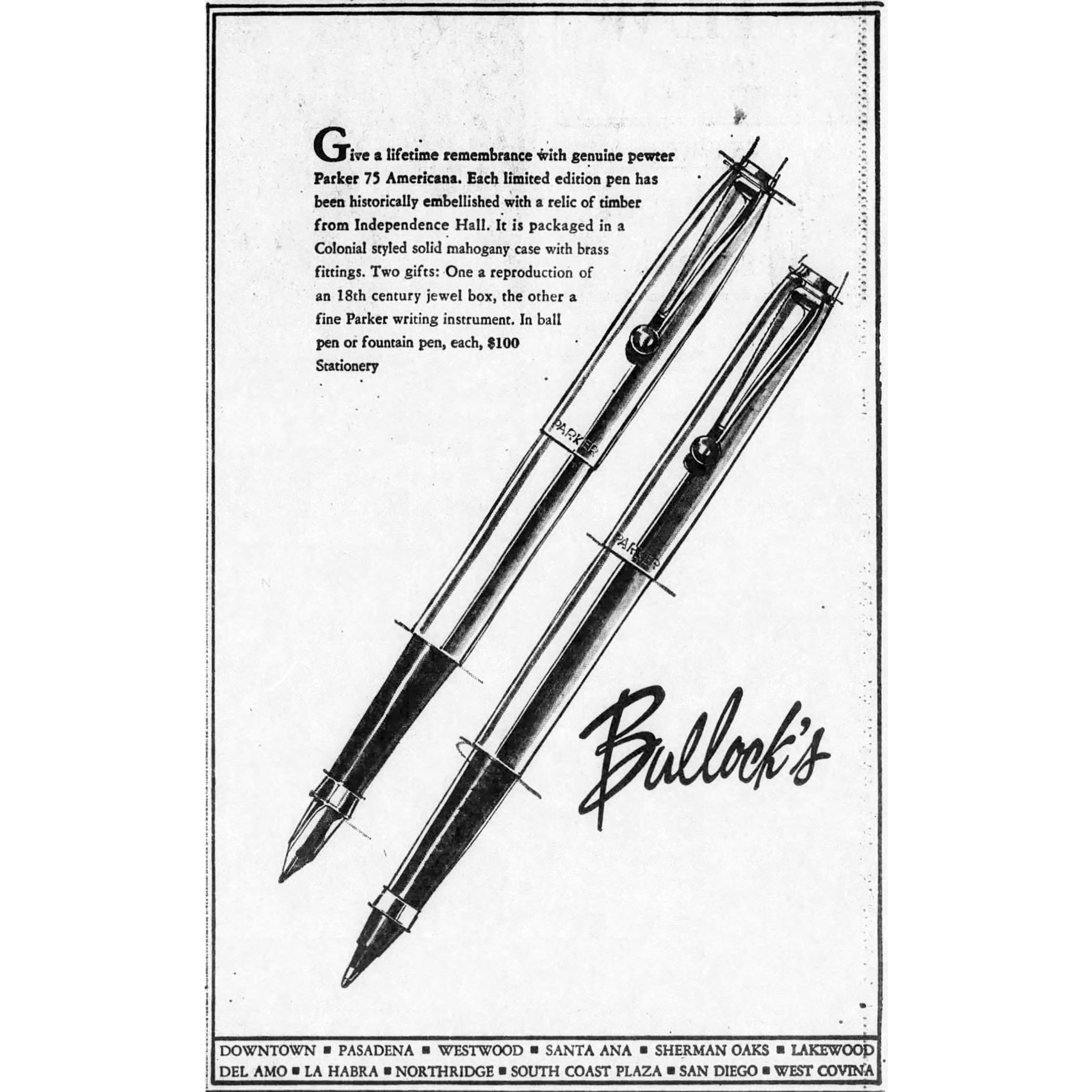 Advertisement in the Los Angeles Times, Los Angeles, California, December 7, 1975
Advertisement in the Los Angeles Times, Los Angeles, California, December 7, 1975
Pewter was also used to create a replica writing stand, or “standish,” that serves as an alternate, and more expensive, presentation box for the pen, crafted to look like one made by Henry Will, an American designer who lived from 1736 to 1802. The original Henry Will box has a hinged lid that allows access to one or both of the two storage areas inside, one to hold quill pens and the other for an inkwell, sand for blotting, and a space for a seal and sealing wax. The presentation box was made by Reed & Barton of Taunton, Massachusetts, and came with a self-adhesive pewter framed wood relic that can be affixed by peeling off the waxy paper on the adhesive backing.
The Parker Bicentennial Desk Sets have a pewter frame that has a block of rosewood and includes an engravable self-adhesive pewter nameplate.
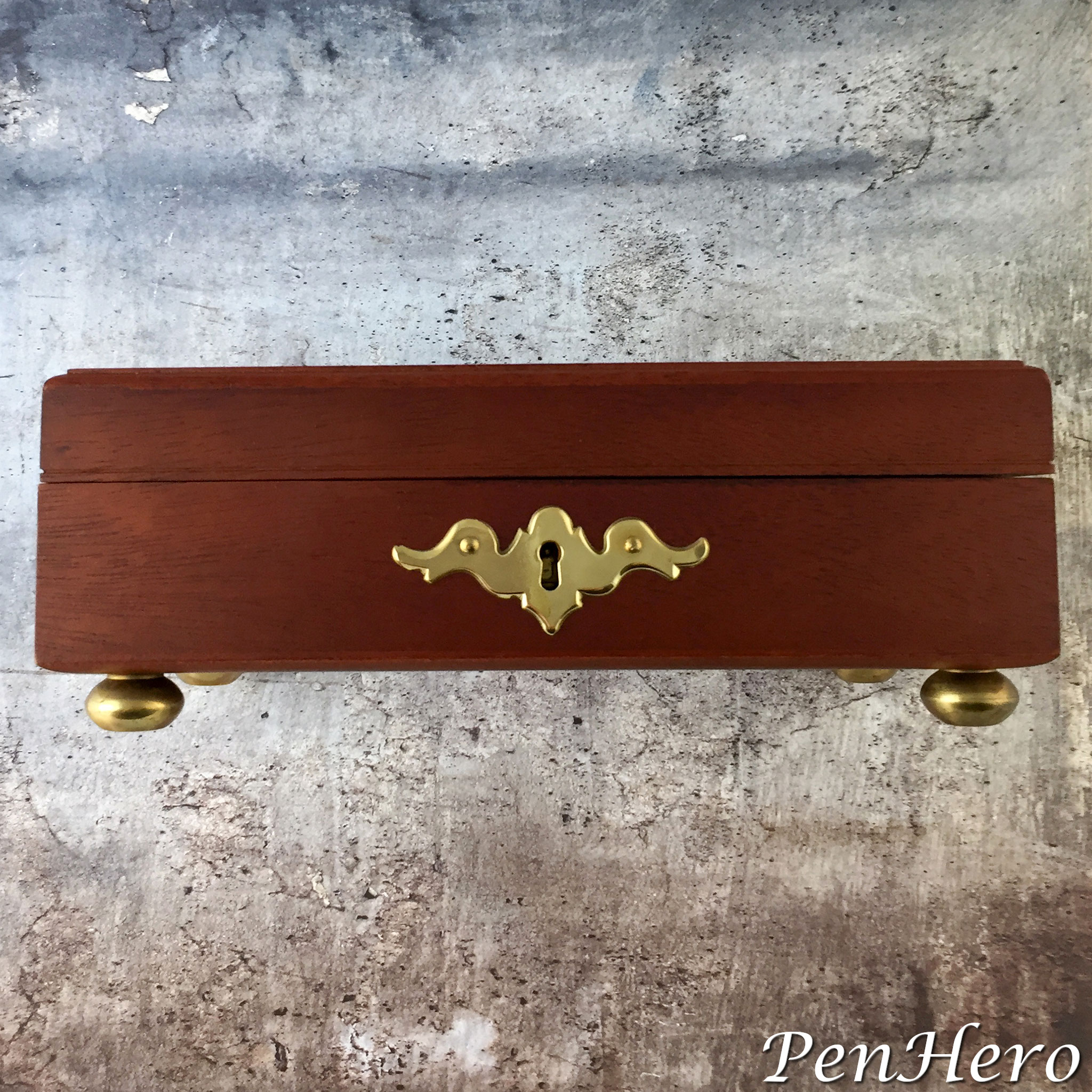 Parker 75 Americana mahogany case
Parker 75 Americana mahogany case
There are some sources that believe the pens did not sell well. Advertisements within the first year of release show the pens being used as premiums for giveaways as well as being sold at a discount. A retailer ad in the November 28, 1975 Orlando Sentinel offered the 75 Americana pen in the mahogany gift box for 40 percent off at $60. About the second year after release, Parker started to offer premiums to dealers to give with the pens to help induce sales of remaining stock. Even though there was a lot of bicentennial fever in 1975 and 1976, 10,000 $100 pens was a lot for the market to absorb. There is even an ad as late as July 2, 1987 in the Tampa Tribune offering the fountain pen or the ball pen in the mahogany gift box for $225.
About Pewter
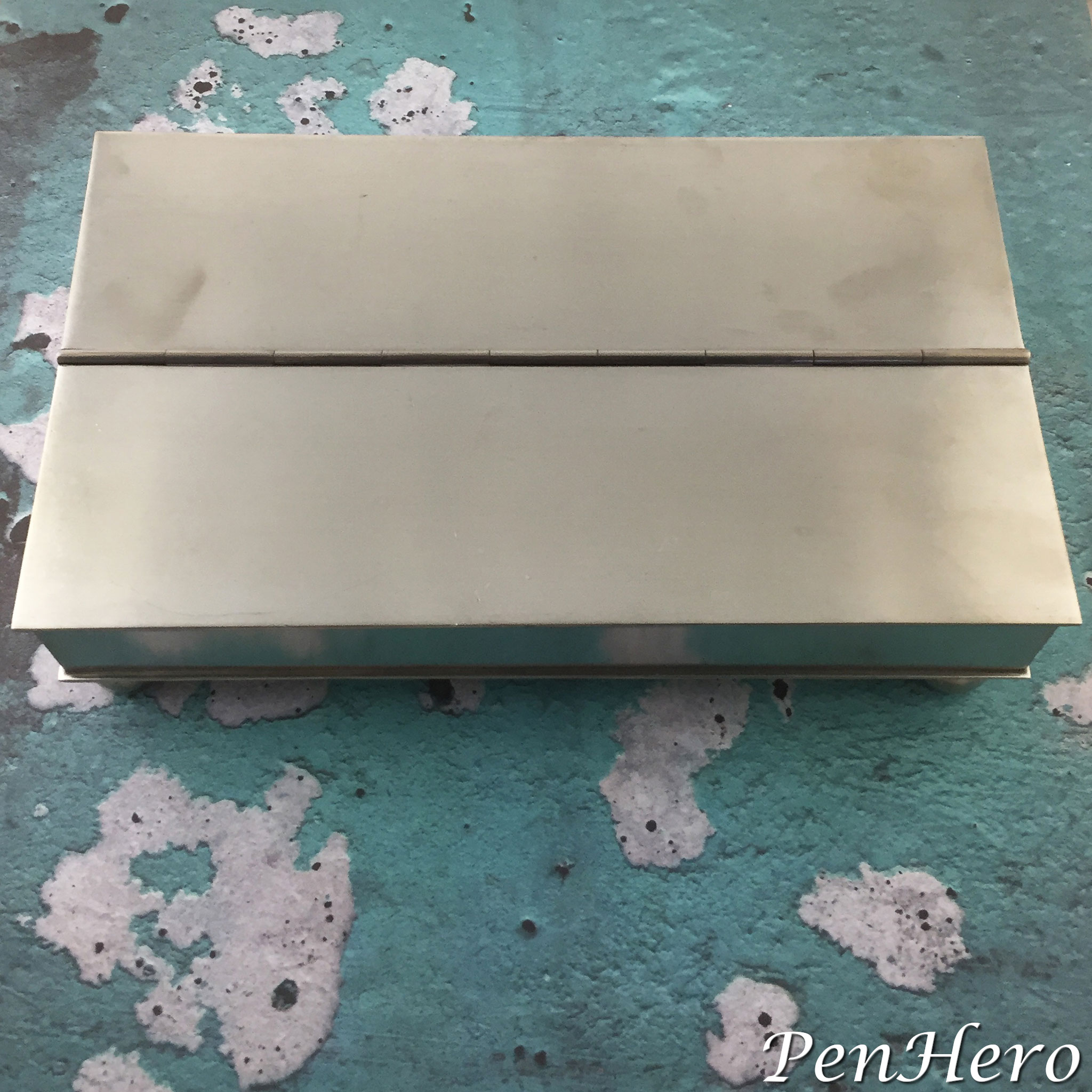 Parker 75 Americana pewter writing stand
Parker 75 Americana pewter writing stand
The choice of pewter was an homage to United States colonial times and Parker called it “colonial pewter.” Pewter, according to the Pewter Society is “an alloy composed primarily of tin with varying quantities of hardening agents such as antimony, bismuth, copper and lead.” Use of pewter can be dated back to ancient Egypt and Rome and was in common use in Europe by the middle ages. By the Renaissance, pewter became a substitute for more expensive silver and gold and was used for household goods such as plates, cutlery, dishes, and drinking vessels. Pewter is more tarnish resistant than silver, but does not polish as nicely, and is softer.
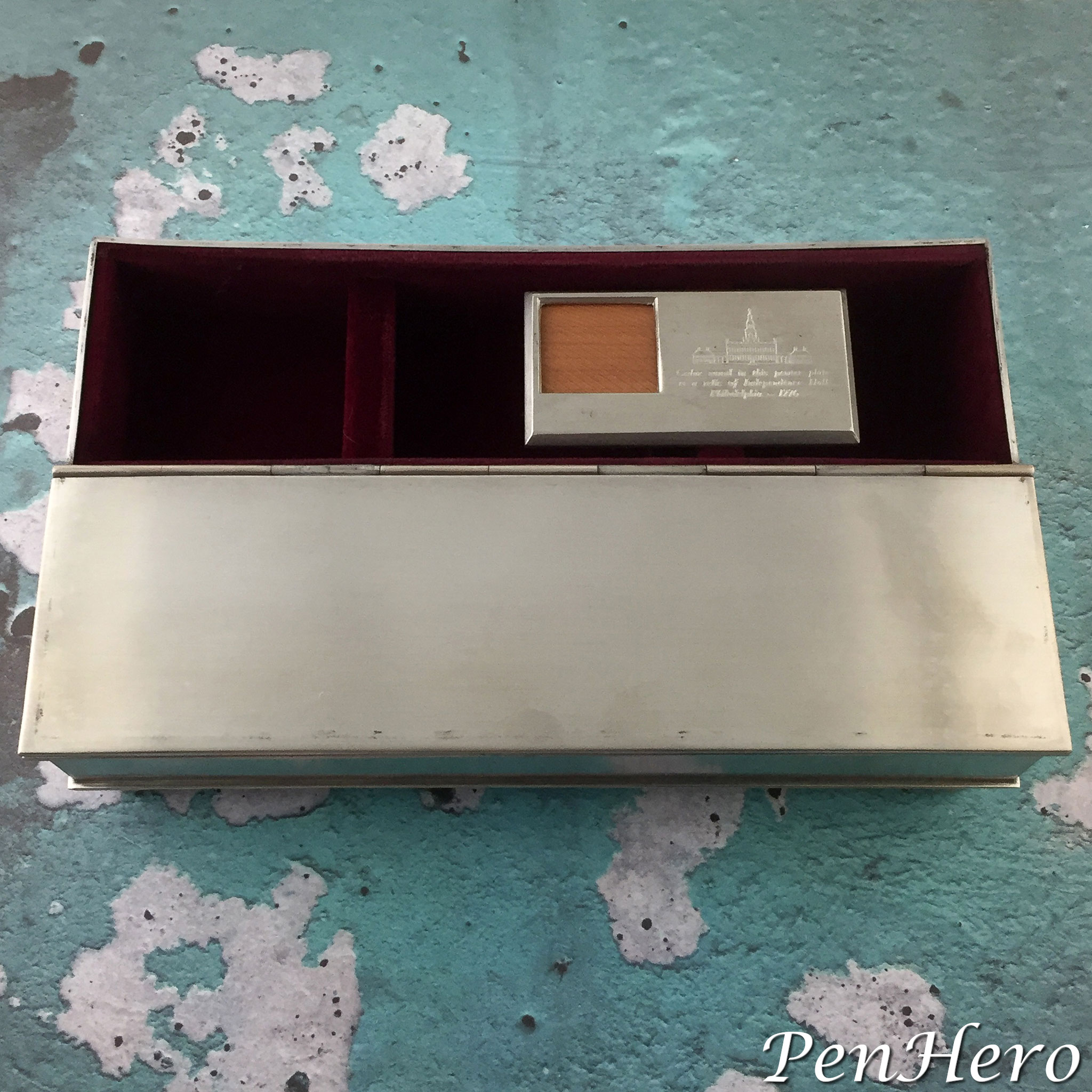 Parker 75 Americana pewter writing stand, partly open
Parker 75 Americana pewter writing stand, partly open
According to The Worshipful Company of Pewterers, a craft guild that traces its history back to the mid 1300s:
“Tin, the major constituent of pewter, is produced from tin ore, the major sources of supply being the Far East and South America. Tin is completely non-toxic, melts at a relatively low temperature (232C), has very good fluidity when molten, has good formability, and readily forms alloys with other metals. It is a relatively soft metal and it is for this reason that it is alloyed with other constituents before being used in the form of pewter.”
There is no lead in modern pewter. Compositions vary, but the European Standard for pewter is 91-5% tin, no more than 8% copper, no more than 2.5% antimony, and 0-5% bismuth.
Identification Guide and Features:
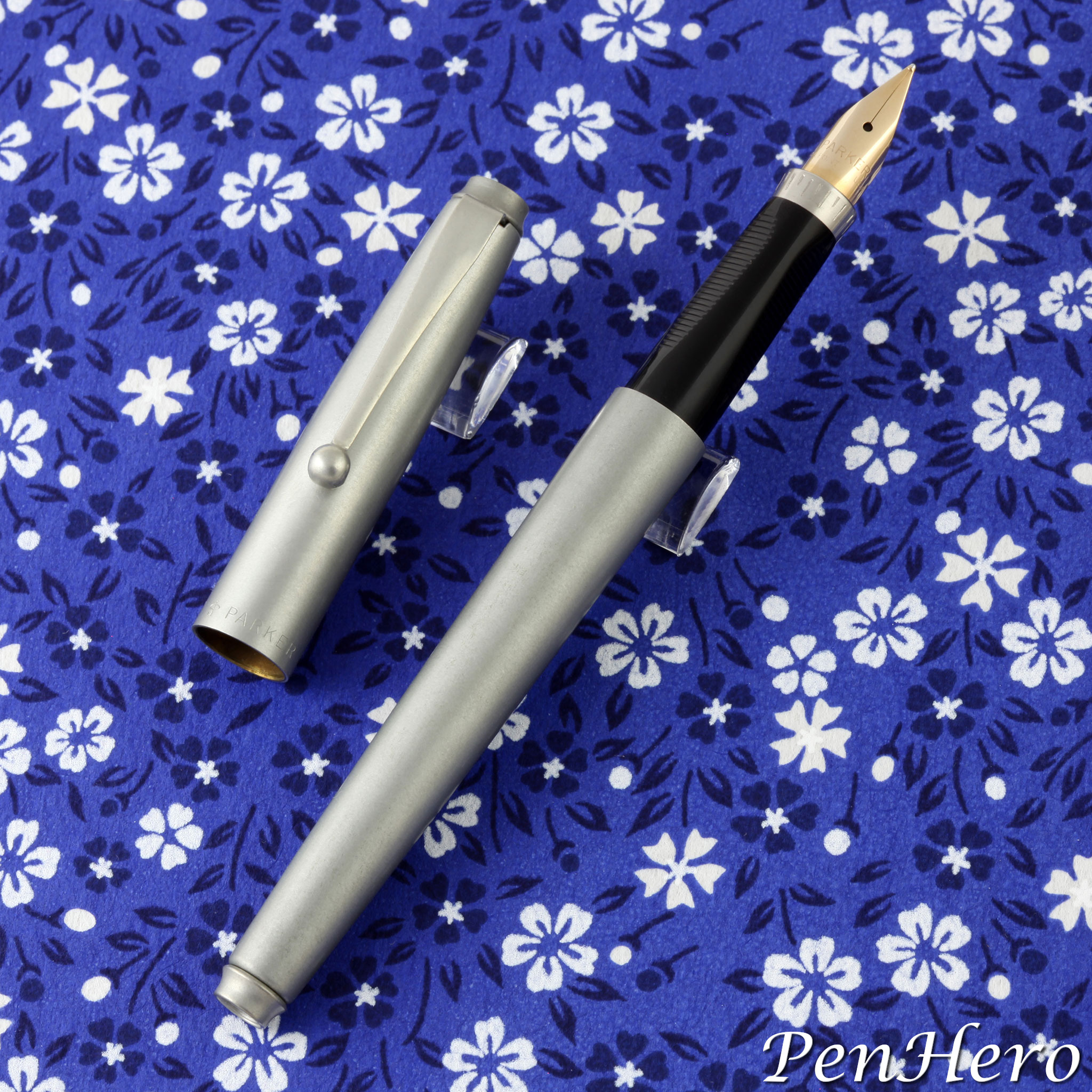 Parker 75 Americana 1975
Parker 75 Americana 1975
The Parker Americana fountain pen is about 5 inches long with a strong monochromatic look from the solid pewter construction. The cap, barrel, clip and tassies all appear to be made of pewter. The cap edge is stamped PARKER on the front and MADE IN U. S. A. on the back. The back of the cap is engraved with an authenticity statement about the wood piece inserted in the cap tassie. There were three versions of the pen: fountain pen (6-579-1), soft tip pen (6-579-2), and ball pen (6-579-1). All of the 75 Americana pens were pull off cap types, like the fountain pen. The 75 Americana ball pen was the same pen as the soft tip pen with the addition of a plastic insert to allow it to use Parker ballpoint cartridges. The original retail price for each was $100, packaged in a mahogany case with brass fittings.
- Pewter cap and barrel
- Tapered ball end clip that appears to be pewter
- Cap edge is stamped PARKER on the front and MADE IN U. S. A. on the back
- Back of the cap is engraved with an authenticity statement about the wood piece inserted in the cap tassie
- Friction fit cap
- 14 karat gold nib stamped PARKER over 14K POINT U.S.A.
- Cartridge / converter filler, uses Parker cartridges
- About 5 inches long capped
- Advertised price for the pen (fountain, soft tip, or ball pen) was $100 with the handmade locking mahogany chest with brass fittings gift box and brass nameplate
The pewter writing stand originally included two 75 Americana pens, the soft tip and ball pens, and retailed for $350. Examples can be found today with the fountain pen.
The Bicentennial Desk Set was made from a solid block of rosewood placed on a pewter frame base. It included a plaque with a square relic of the wood from Independence Hall in a pewter frame on the top and an engravable pewter nameplate. It retailed with two Parker Classic brushed stainless steel ballpoint desk pens for $200.
Not to let the Bicentennial celebration pass without selling a prospective customer something, Parker also released a set of “Freedom Cube” desk sets. These were 2 inch cubes in either aluminum with a stainless steel Classic ballpoint desk pen for $25 or jet black plastic with a black plastic Jotter ballpoint desk pen for $10. The bases have pewter “American Freedom” medallions that depict scenes from the period, each with a “Spirit of ‘76” banner. The Liberty Bell medallion shows the cracked Liberty Bell. The Independence medallion shows a portion of the John Trumbell painting where Thomas Jefferson presents the Declaration of Independence to John Hancock, the president of the Continental Congress. The Minute Man medallion shows a statue that looks like the Minute Man statue by Daniel Chester French in Concord, Massachusetts. The Spirit of ’76 medallion shows the part of Archibald Willard’s painting of the fife and drum corps.
Performance
I did not have a chance to try out these pens as they were set aside for sale some time ago, so there won’t be a full performance section, but I do have some thoughts.
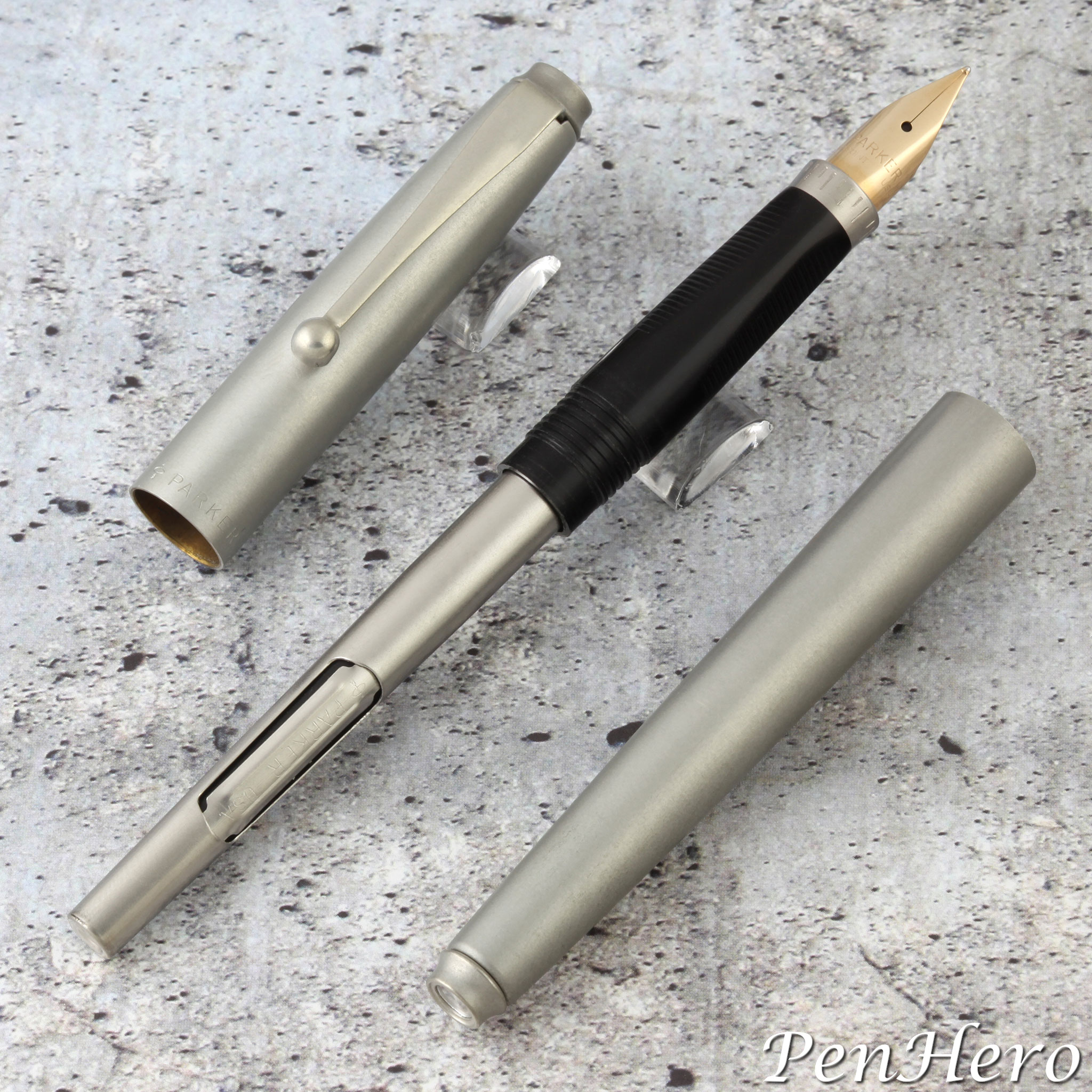 Parker 75 Americana 1975
Parker 75 Americana 1975
These are Parker 75 pens, so the size, nib and grip is going to be familiar to fans of those pens. As would be expected, they are about the same size, shape and weight as the c. 1964 - 1993 sterling silver crosshatch Ciselé, but with a smooth surface and a different clip. The nib is the same, and if you like writing with the Parker 75, the experience would be the same. Because it’s a 75, the section would be exchangeable with any other similar Parker 75 to give some options on writing. The cartridge / converter system is very good and familiar, and the squeeze converter will do a good job.
Because it’s made of pewter, it’s going to maintain a fairly dull or muted look, and I would not bother polishing it, only making sure to keep it clean. The finish will pick up fine scratches and patina like a sterling silver pen, and I think it will add to the character of the pen over time. One of the two example pens for this article was already showing that quality and it looks good to me.
My experience is the Parker 75 Americana pens are somewhat less sought after than the other Parker 75 limited editions and many of the standard finishes. After having a couple of them in person I can see why. They don't really seem like a Parker 75, but rather a new pen with a Parker 75 section.
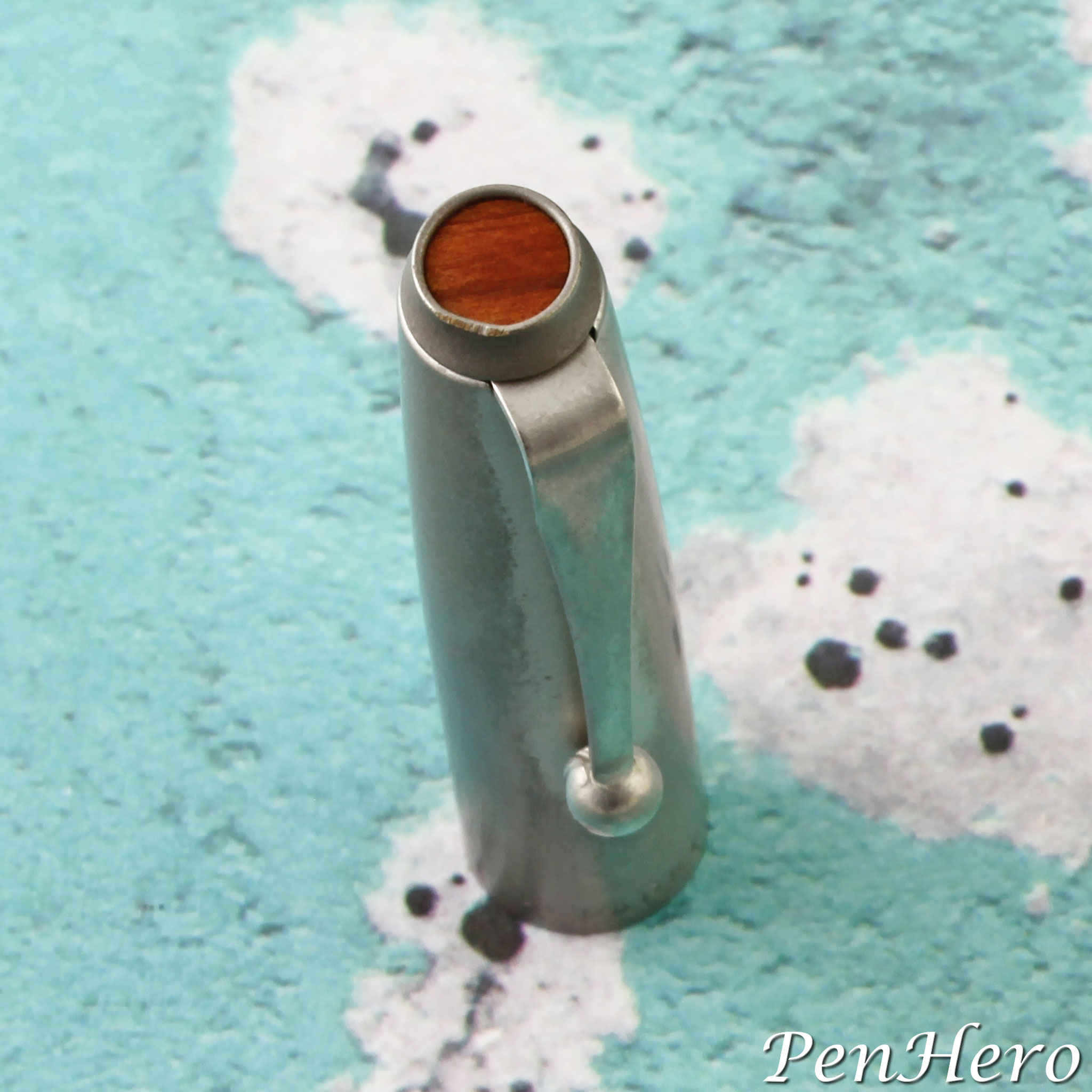 Cap top detail showing wood relic piece
Cap top detail showing wood relic piece
The appeal seems to be about the Bicentennial / Colonial period and to hard core Parker 75 collectors who must have every model. They do show up from time to time and prices seem to be driven more by what the seller thinks they’re worth more than what the buyer may want to pay. The mahogany and pewter gift boxes are interesting if you are a completist, but they are big and bulky. If you want one of these pens, be patient and you may find one for a reasonable price!
References
“75 Americana Pens” brochure, Parker Pen Company, undated, but probably 1975
Advertisement, Morning News, Sunday News Journal TV section, Wilmington, Delaware, September 7, 1975, page 31
Advertisement, National Geographic, November 1975
Advertisement, Orlando Sentinel, Orlando, Florida, November 28, 1975, page 29
Advertisement, Orlando Sentinel, Orlando, Florida, December 14, 1975, page 25
Advertisement, Tampa Tribune, Tampa, Florida, July 2, 1987, page 23-H
Advertisement, Tampa Tribune, Tampa, Florida, December 24, 1975, page 7-A
Advertisement, The Los Angeles Times, Los Angeles, California, December 7, 1975, part V, page 2
Advertisement, The Morning News, Wilmington, Delaware, September 8, 1976, page 8
Advertisement, The News Journal, Wilmington, Delaware, August 24, 1976, page 6
Advertisement, The Tennessean, Nashville, Tennessee, June 30, 1976, page 5
Bicentennial – 1976, Parker75.com, Copyright © 2000-2013, Lih-Tah Wong
“Bicentennial Desk Sets” brochure, Parker Pen Company, undated, but probably 1975
“Demand for fountain pens has remained firm” by Harry Costello, The Tampa Times, Tampa, Florida, December 22, 1975, page 9
“Parker Bicentennial Pens and Desk Sets” brochure, Parker Pen Company, undated, but probably 1975
“Only from Parker… a piece of American History” brochure, Parker Pen Company, May 1975
Parker Calendar, Cheryl Hayes, Product Quality & Development Dept, Newhaven, UK, undated, created June 27, 2000 and updated through June 26, 2002
“Pen business not the same as 28 years ago for Bob Howard” by Karen Lachenauer, The Tampa Times, Tampa, Florida, December 22, 1975, page 9
Pewter, The Worshipful Company of Pewterers © 2018
Shoptalker, Parker Pen Company, March 2, 1981, Issue 1042
“Sunken Spanish Treasure Made Into Fountain Pens” by Ian Ker, Press Release Service, Parker Pen Company, New York, NY, November 5, 1965
The Metal, The Pewter Society
The Minute Man statue by Daniel Chester French, National Park Service
United States Patent 1,197,224, awarded September 5, 1916 to William E. Moore of Janesville, Wisconsin, assignor to The Parker Pen Company
Interact
Comments on this article may be sent to the author, Jim Mamoulides


